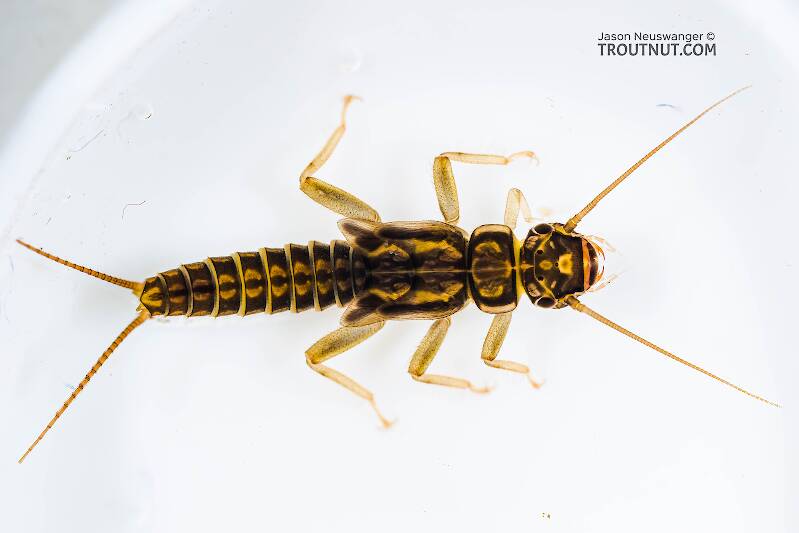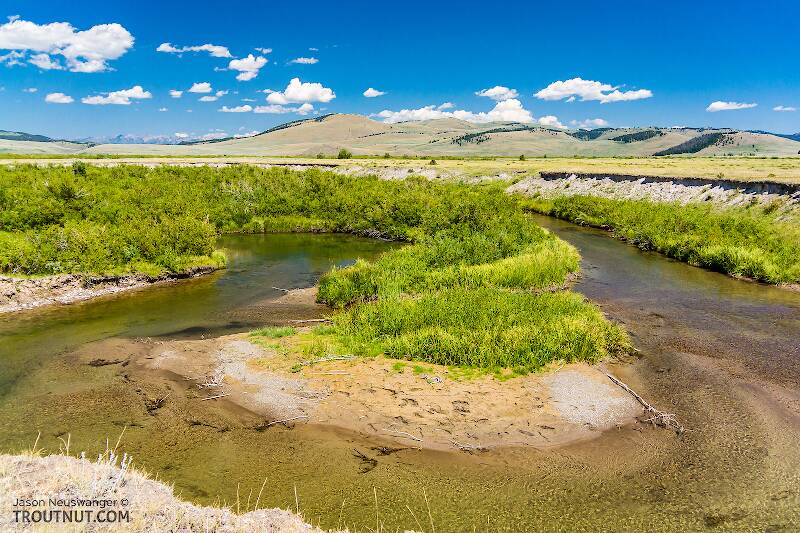
Salmonflies
Pteronarcys californica
The giant Salmonflies of the Western mountains are legendary for their proclivity to elicit consistent dry-fly action and ferocious strikes.


Mayfly Species Labiobaetis frondalis
Where & when
In 4 records from GBIF, adults of this species have been collected during June (75%) and May (25%).
Species Range
Physical description
Most physical descriptions on Troutnut are direct or slightly edited quotes from the original scientific sources describing or updating the species, although there may be errors in copying them to this website. Such descriptions aren't always definitive, because species often turn out to be more variable than the original describers observed. In some cases, only a single specimen was described! However, they are useful starting points.
Male Spinner
Wing length: 4.5-6 mm
Abdominal tergites 2-6 of male imago deep brown; genitalia of the moffati type (now a synonym of Baetis tricaudatus); a deep excavation between the bases of the forceps, in which is a short spine.
Head and thorax deep shiny black. Brown markings on the pleural sutures. Legs pale yellowish brown. Wings hyaline. Stigmatic cross veins of the fore wing few in number, not anastomosing; no intercalaries in the first interspace. Hind wing long and narrow, the margins sub-parallel; third vein reduced to a mere trace. Costal projection greatly reduced (see fig. 163).
Abdominal tergites 2-6 deep brown; the anterior margins, especially laterally, pale and partially semi-translucent. Tergites 7-10 opaque, deep brown. Sternites pale dull cream-colored, the opaque apical ones with partial brown shading. Tails and forceps pale. The third joint of the forceps is long and narrow, the apical one very short and somewhat truncate. Between the bases of the forceps is a deep excavation, covered by a small triangular plate; a small spine is situated at the base of the excavation (see fig. 164).
This species is very similar to australis (now a synonym of Labiobaetis frondalis), from which species it may be distinguished by the greater amount of brown shading on the basal abdominal tergites, and the somewhat darker legs.
Described as B. australis
Body length 5 mm, wing length 4.5-5 mm
Abdominal tergites 2-6 of male imago purplish brown in lateral and posterior portions, the median and antero-lateral areas pale, semi-hyaline; genitalia of the moffati type (now a synonym of Baetis tricaudatus); an excavation between the bases of the forceps, in which is a small spine.
Turbinate eyes large, oval, orange in color. Thorax deep ruddy brown. Intersegmental areas of the pleura yellowish. Anterior portion of mesosternum lighter yellowish brown. Legs pale yellowish white. Wings hyaline, venation pale. 6-8 stigmatic cross veins in the fore wing, not anastomosing; only the two most apical ones of these reach the subcosta. Stigmatic area somewhat opaque. No intercalaries in the first interspace. Hind wing rather long and narrow; the third vein wanting or obsolescent, mere traces of it sometimes seen at the extreme base. A very short intercalary may be present between veins 1 and 2. Costal projection much reduced.
Tergites 2-6 largely pale, semi-hyaline, in the dorsal area, with faint submedian brownish streaks; antero-lateral margins also pale. Remainder of each tergite purplish brown. Tergites 7-10 opaque, reddish brown, with a purplish tinge. Sternites greyish white, semi-translucent. A continuous double blackish line outlines the tracheae on each side; from it arise branches which extend on to the tergites and sternites. In the holotype, the upper of these is the longer. Between the bases of the forceps is an excavation, at the base of which is a short spine, much as in frondalis (now a synonym of Labiobaetis frondalis); a penis-cover also is present, over this excavation (see fig. 164).
While close to B. frondalis, this species is slightly more slender, and the basal abdominal tergites exhibit more pale areas. The excavation between the bases of the forceps is also less deeply carved out.
Start a Discussion of Labiobaetis frondalis
References
- Needham, James G., Jay R. Traver, and Yin-Chi Hsu. 1935. The Biology of Mayflies. Comstock Publishing Company, Inc.
Mayfly Species Labiobaetis frondalis
Species Range
Resources
- NatureServe
- Integrated Taxonomic Information System
- Global Biodiversity Information Facility
- Described by McDunnough (1925)

